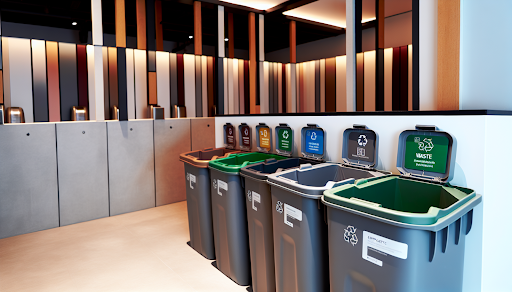Top 7 Strategies for Achieving Restaurant Sustainability Success
By Anttoni Taimela · 31. January 2024
Seeking restaurant sustainability? Master it with seven transformative strategies.
This guide unveils how to refine your operations for environmental impact and customer appeal.
Embark on a journey to sustainable🌱 sourcing, efficient waste management, and smart energy use—key steps to a thriving, responsible eatery.
Primary Insights
- Restaurant sustainability isn’t just good for Earth – it’s great for business, attracting eco-friendly customers and giving the economy a green thumbs up.
- From farm-fresh sourcing to turning off the lights, sustainable restaurants are rocking four main areas: food sourcing, waste management, energy efficiency, and eco-friendly practices.
- Sustainability isn’t a side dish; for restaurants, it’s the main course of continuous improvement, tracking progress, and spreading the green gospel to diners and staff alike.
Understanding the Importance of Restaurant Sustainability
 eco restaurant
eco restaurant
In the bustling world of food businesses, restaurant sustainability is the superhero we’ve all been waiting for.
This isn’t about just reducing food waste or minimizing energy consumption.
It’s about creating a more sustainable restaurant that cares for the natural environment, contributes to economic prosperity, and prepares a better world for future generations.
You may wonder what the benefits are for the restaurants. Well, sustainability in restaurants is not just an act of environmental kindness.
It’s a ticket to boosting the restaurant’s image, attracting eco-friendly customers, and adding a touch of sparkle to the economy.
Talk about a win-win🏆 situation!.
Key Components of a Sustainable Restaurant
 waste management
waste management
Let’s unfold the major elements that make a restaurant sustainable. Ever heard of the fantastic four of restaurant sustainability? They are:
- Food Sourcing
- Waste Management
- Energy Efficiency
- Eco-Friendly Practices
Each plays a vital role in the sustainability strategy of a restaurant, contributing to reducing its carbon footprint and embracing a more sustainable restaurant model.
These components are not just about being a part of the current restaurant sustainability trends.
They are about creating a green restaurant that respects the natural resources, understands the impact of its actions on climate change, and aims for continuous improvement in its sustainability practices.
Food Sourcing
Beginning with Food Sourcing, the first of our fantastic four in the food industry, it’s not solely about procuring the freshest ingredients.
It’s about prioritizing local, seasonal, and sustainable ingredients.
This approach not only gives a nod to local farmers but also cuts down on emissions and serves up some one-of-a-kind dining experiences.
You might question the need for restaurants to focus on sustainable food sourcing. Well, it’s simple. Sustainable food sourcing can:
- Elevate a restaurant’s menu to a whole new level of refinement, variety, and quality
- Bring a little piece of the farm straight to your plate
- Minimize food waste
Now, who wouldn’t want that?
Waste Management
Waste Management, the next crucial element of our quartet, plays a significant role in restaurant sustainability.
This component is all about reducing food waste and recycling.
It’s about showing off our responsible stewardship of resources and minimizing food waste to lessen the environmental impact.
You may be wondering how restaurants can enhance their recycling practices.
It’s all about having the right recycling bins for tin, glass, plastics, and cardboard, and making sure everything gets recycled. And the perks?
Well, they get to be more efficient, save on energy, and cut costs.
Energy Efficiency
The third element of our quartet, Energy Efficiency, primarily focuses on reducing energy consumption.
By investing in energy-efficient appliances and lighting, restaurants can save some dough on utility bills while also doing their part in reducing their environmental footprint, carbon emissions, and greenhouse gas emissions.
Smart thermostats and energy management systems can optimize efficiency and track energy use, conserving resources and reducing energy consumption.
And to get the staff on board with saving energy, restaurants can place reminder signs and add motion-sensor-activated light switches to keep that energy usage in check.
Eco-Friendly Practices
Finally, Eco-Friendly Practices involve:
- the adoption of sustainable materials
- environmentally-friendly methods
- using eco-friendly cleaning products
- furniture made from environmentally conscious recycled materials
- promoting water conservation.
Restaurants can impress everyone by using biodegradable, recyclable, and reusable packaging.
To get customers in on the action, they can offer incentives like discounts for bringing their own containers and provide guides for proper packaging disposal.
And hey, promoting their efforts through social media and other platforms is a surefire way to get customers on board.
Implementing Sustainable Menu Options
To further enhance food sustainability, consider exploring sustainable menu options.
Offering plant-based dishes and focusing on sustainable seafood can cater to diverse diets and reduce environmental impact.
You might ponder the necessity of offering vegetarian and vegan options in restaurants.
Well, by providing these options, restaurants can show they care about the planet and attract a whole new crowd. It’s a win-win situation for both the environment and their business.
Engaging Staff and Customers in Sustainability Efforts
 customer reviews
customer reviews
A successful sustainability strategy involves not only the implementation of sustainable practices but also the engagement of staff and customers.
After all, a restaurant’s sustainability is a shared responsibility.
Restaurants can expand the knowledge of its staff on sustainable practices by nudging them to attend sustainability-related workshops, conferences, or training programs focused on restaurant sustainability practices.
It’s about creating a culture of sustainability within the restaurant and making everyone a part of the journey.
Collaborating with Local Partners
Beyond the confines of the restaurant, sustainability also necessitates collaboration with local partners.
Teaming up with local farmers, suppliers, and waste management companies can give sustainable restaurants a leg up in reaching their sustainability goals while also giving a high-five to the local community.
By joining the Sustainable Restaurant Association, they can further enhance their commitment to eco-friendly practices.
Working with local suppliers offers a delightful feast of benefits:
- Top-notch, fresh ingredients
- Eco-friendly practices
- Healthier produce
- Support for the local economy
- Sparking innovation and customization
Now, isn’t that a delightful feast of benefits?
Measuring and Monitoring Sustainability Progress
Sustainability is not a one-off initiative but rather a continuous journey of improvement.
And to ensure continuous improvement, measuring and monitoring sustainability progress is crucial. Restaurants should track key performance indicators such as:
- Water usage
- Energy usage
- Food waste
- Non-food waste
- Carbon footprint per meal served
Setting up a system to track and consistently review data tied to sustainability goals is essential.
For this, restaurants can use various tools and software like guest-facing point of sale technology, kitchen display screens, and restaurant inventory management software.
After all, what gets measured gets improved, right?.
Promoting Your Sustainable Restaurant
Sustainability extends beyond the implementation of sustainable practices; it also involves promoting your eco-friendly restaurant.
Communicating your sustainability efforts through marketing and social media can attract eco-conscious customers and build brand loyalty.
In the restaurant industry, restaurants can also:
- Host events
- Team up with local organizations
- Gather feedback
- Show off any relevant certifications
This can not only attract new customers but also create a sense of community among regular customers.
Summary
In a nutshell, restaurant sustainability is about more than just minimizing food waste or reducing energy consumption.
It’s a holistic approach encompassing everything from sourcing local and sustainable ingredients, managing waste effectively, using energy-efficient appliances, and promoting eco-friendly practices, to implementing sustainable menu options, engaging staff and customers, collaborating with local partners, measuring progress, and promoting your green efforts.

